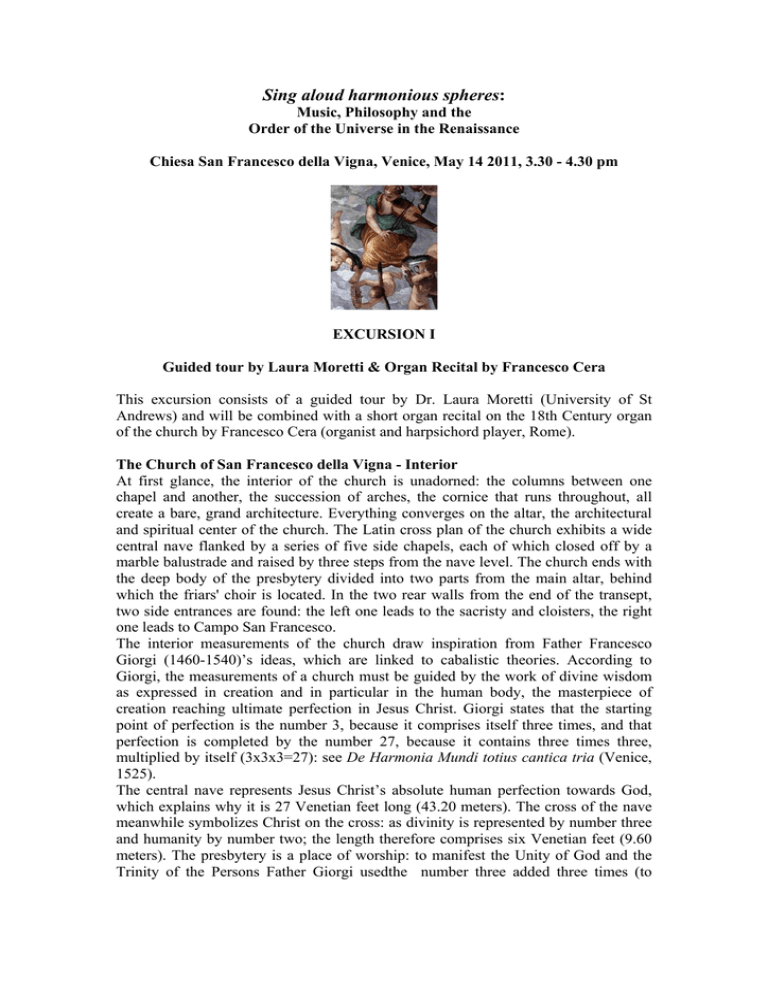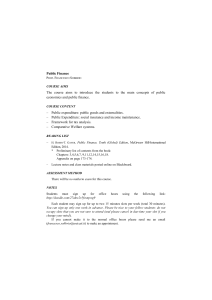Sing aloud harmonious spheres
advertisement

Sing aloud harmonious spheres: Music, Philosophy and the Order of the Universe in the Renaissance Chiesa San Francesco della Vigna, Venice, May 14 2011, 3.30 - 4.30 pm EXCURSION I Guided tour by Laura Moretti & Organ Recital by Francesco Cera This excursion consists of a guided tour by Dr. Laura Moretti (University of St Andrews) and will be combined with a short organ recital on the 18th Century organ of the church by Francesco Cera (organist and harpsichord player, Rome). The Church of San Francesco della Vigna - Interior At first glance, the interior of the church is unadorned: the columns between one chapel and another, the succession of arches, the cornice that runs throughout, all create a bare, grand architecture. Everything converges on the altar, the architectural and spiritual center of the church. The Latin cross plan of the church exhibits a wide central nave flanked by a series of five side chapels, each of which closed off by a marble balustrade and raised by three steps from the nave level. The church ends with the deep body of the presbytery divided into two parts from the main altar, behind which the friars' choir is located. In the two rear walls from the end of the transept, two side entrances are found: the left one leads to the sacristy and cloisters, the right one leads to Campo San Francesco. The interior measurements of the church draw inspiration from Father Francesco Giorgi (1460-1540)’s ideas, which are linked to cabalistic theories. According to Giorgi, the measurements of a church must be guided by the work of divine wisdom as expressed in creation and in particular in the human body, the masterpiece of creation reaching ultimate perfection in Jesus Christ. Giorgi states that the starting point of perfection is the number 3, because it comprises itself three times, and that perfection is completed by the number 27, because it contains three times three, multiplied by itself (3x3x3=27): see De Harmonia Mundi totius cantica tria (Venice, 1525). The central nave represents Jesus Christ’s absolute human perfection towards God, which explains why it is 27 Venetian feet long (43.20 meters). The cross of the nave meanwhile symbolizes Christ on the cross: as divinity is represented by number three and humanity by number two; the length therefore comprises six Venetian feet (9.60 meters). The presbytery is a place of worship: to manifest the Unity of God and the Trinity of the Persons Father Giorgi usedthe number three added three times (to represent the equality of the three persons of the Trinity); the presbytery is subsequently nine Venetian feet long (13.40 meters). The choir is devoted especially to the prayer of the clergy; they are united in prayer with the Nine Choirs of Angels; therefore the choir is nine Venetian feet long (13.40 meters). Christians, who form the mystical body of Christ, i.e. the church, are not perfect; they are sanctified by the three persons of the Trinity (3x3). Imperfect mankind (represented by number two) cooperates, but remains limited. The result is: 3x3=9; 9x2=18. The church is in fact 18 Venetian feet wide (28.80 meters). In this world, mankind knows God with his reason, an imperfect means. Father Giorgi conveys this fact by applying the number 9 to God and the number 2 to mankind. Using this logic, the height of the church corresponds to 9x2, or 18, Venetian feet (28.60 meters). The chapels of the central body of the church are 12 in number because the church is founded on Christ (central nave) but grows and matures with the 12 Apostles. Practical Information Address San Francesco della Vigna Campo San Francesco della Vigna, 2786 30122 Venezia, Italy tel. 041 5206102 Stop public transport: Venezia Fondamenta Nuove Directions (how to reach the Church from the Palazzo Pesaro Papafava): From the Palazzo Papafava (Palazzo Pesaro Papafava, Cannaregio, Calle de la Racchetta, 3764, 30121 Venice, tel. 340 832 3359) to the San Francesco della Vigna Church: By public transport (approx. 30 minutes) http://maps.google.co.uk/maps?hl=en&tab=wl Walk (approx. 20 minutes) http://maps.google.co.uk/maps?hl=en&tab=wl
